Published 2021-05-26.
Last modified 2021-05-28.
Time to read: 3 minutes.
django collection.
Documenting custom Django apps is made convenient by using the Django admin documentation generator. Django documentation standards are defined here. These documentation standards were written for Django contributors; Django uses Sphinx for creating documentation. The Django admin documentation generator supports a subset of Sphinx-compatible reStructured text.
Installation
The Python docutils library must be installed in the virtual Python installation
before the documentation feature can be configured.
For me, that meant adding a line consisting of just had one word, docutils, to
dev.requirements.in, and typing:
(aw) $ pip install docutils Collecting docutils Downloading docutils-0.17.1-py2.py3-none-any.whl (575 kB) |████████████████████████████████| 575 kB 1.7 MB/s Installing collected packages: docutils Successfully installed docutils-0.17.1
Tragedy of the Commons
Unlike most of Python, Docutils is still on SourceForge and uses Subversion instead of Git. Clearly this module is stable, but it has been allowed to grow moldy for 10 years or more. The plea for help is clearly visible, and it is at revision 8631!
Beyond just needing a champion, what is really needed is proper funding, which means corporations that use Django should realize that their free ride on F/OSS is not sustainable.
Setup
I added the following to INSTALLED_APPS and MIDDLEWARE in settings:
INSTALLED_APPS = [ ... 'django.contrib.admindocs', ... ]
MIDDLEWARE = [ ... 'django.contrib.admindocs.middleware.XViewMiddleware', ... ]
A new route is required, just one new route for the entire Django webapp.
For my Django webapp, the new route was placed in main/urls.py, just above the admin route.
The documentation was not sufficiently explicit about this for me to understand exactly what was required,
so at first, I added the route to all of my Django apps.
This caused one of my apps to hijack the URL.
The correct placement of the URL is:
from django.urls import include, path, re_path
urlpatterns = [ ... path(route='admin/doc/', include('django.contrib.admindocs.urls')), re_path(route=r'^admin\/?', view=admin.site.urls), ...
Autogeneration
Each time the Django webapp is restarted the documentation is regenerated. The process is very quick. I found it convenient to view the generated documentation for a model class, and tweak it, restarting the webapp each time that I made a significant change so I could inspect the result.
Upon reviewing the generated documentation,
I realized that I had not been providing help_text attributes for many of my Django model field definitions.
The Django documentation generator incorporated the help_text attributes into the generated documentation.
help_text attributes are not HTML-escaped, so they must not contain HTML.
I was unable to find documentation on formatting or linking to model fields.
Viewing the Documentation
The entire Django webapp’s documentation is generated when the Django webapp starts.
After setting up, a new link called Documentation was displayed on the
admin page, and it pointed to
http://localhost:8000/admin/doc/
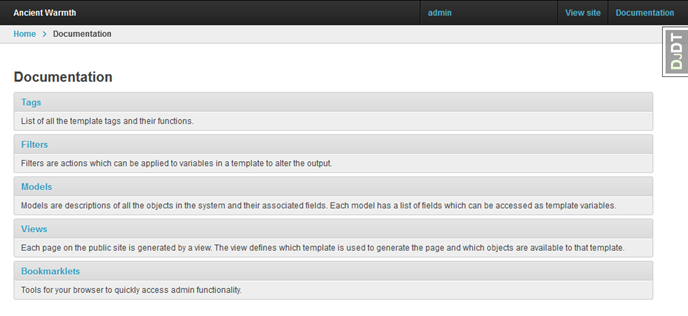
Each of the links on the main documentation page is shown in the images below.
Tag Documentation
Tags are viewable at http://localhost:8000/admin/doc/tags/
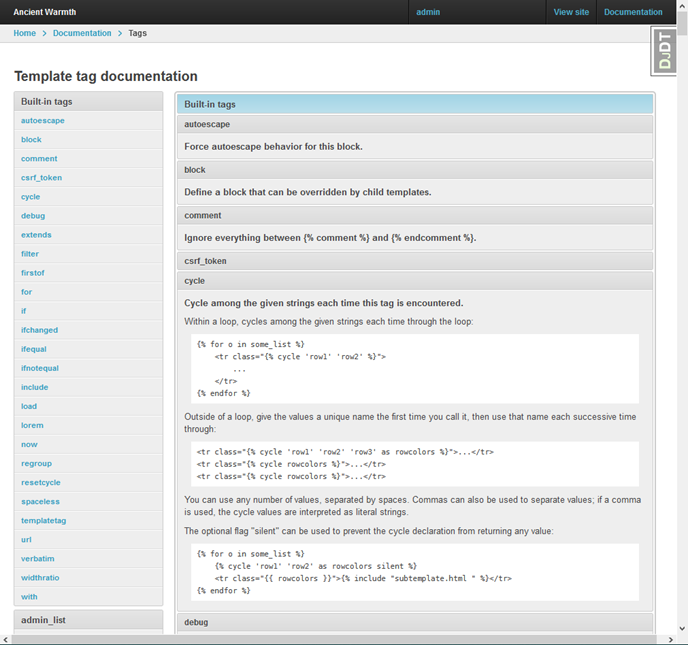
Filter Documentation
Filters are viewable at http://localhost:8000/admin/doc/filters/
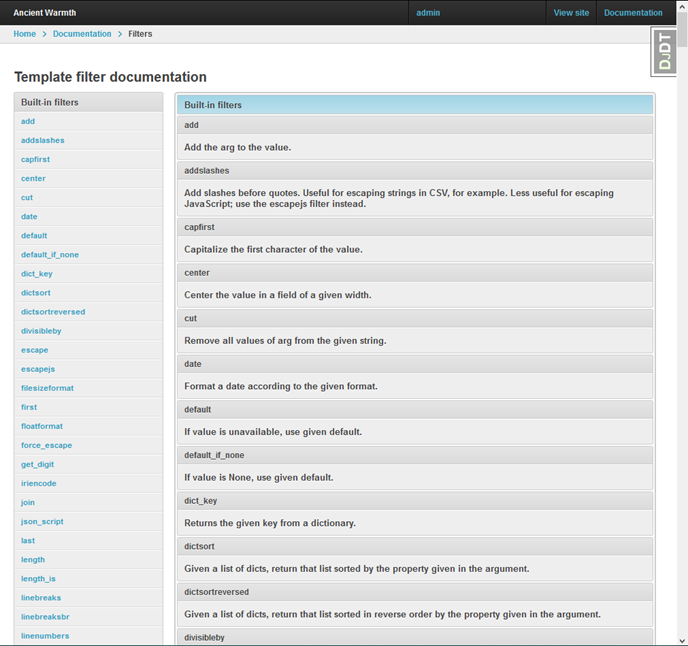
Model Documentation
A clickable listing of all Django models for your webapp is available at
http://localhost:8000/admin/doc/models/
address.UserAddressauth.Permissionauth.Siteauth.Userbasket.Basketbasket.Linebasket.LineAttributecatalogue.AttributeOptioncatalogue.AttributeOptionGroupcatalogue.Categorycatalogue.Optioncatalogue.Productcatalogue.ProductAttributecatalogue.ProductAttributeValuecatalogue.ProductClasscatalogue.ProductRecommendationcustomer.ProductAlertflatpages.Flatpageoffer.Conditionoffer.ConditionalOfferoffer.Rangeorder.Orderpartner.Partnerpartner.StockAlertpartner.StockRecordpayment.Transactionreviews.Voteshipping.OrderAndItemChargesvoucher.Vouchervoucher.VoucherApplicationvoucher.VoucherSetvoucher.VoucherSetwishlists.Linewishlists.WishList
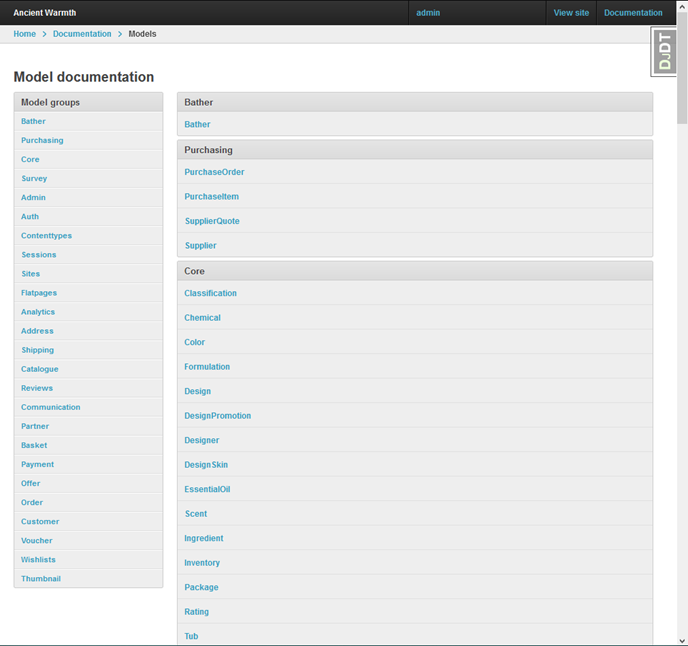
View Documentation
Views are viewable at http://localhost:8000/admin/doc/views/
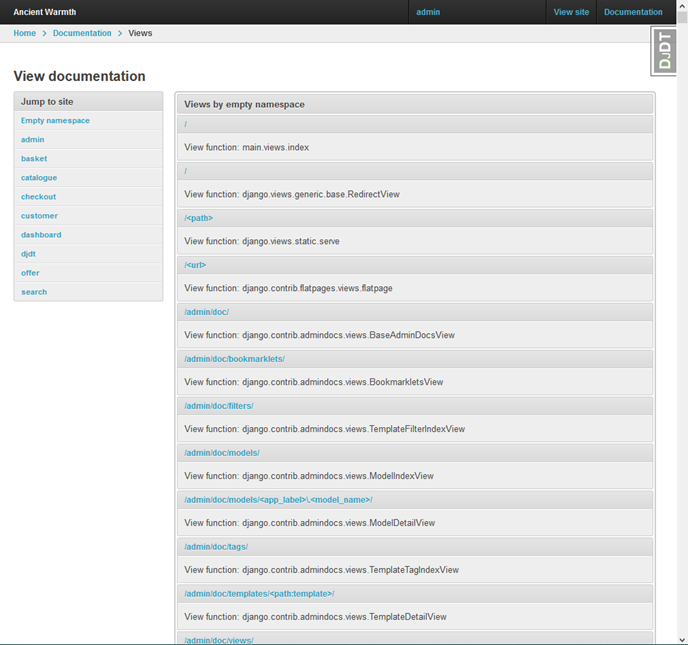
Bookmarklets
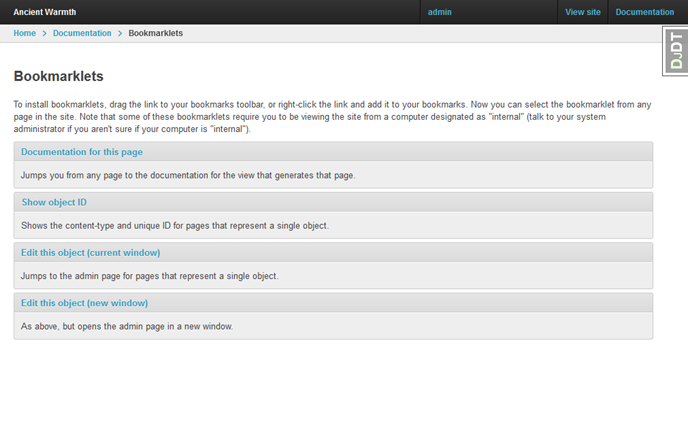
About Bookmarklets
The official documentation for Django bookmarklets is skimpy and inaccurate, and all the other documentation on this feature that I was able to find is badly out of date and incomplete. The feature is completely broken, another example of Django bitrot.
This (updated) information is based on two sources, plus my own investigation:
- James Bennett’s Documentation bookmarklets, published in November 2007.
- The official Django documentation.
Bookmarklets are bits of JavaScript to be dragged into your browser’s bookmarks bar, and then clicked when visiting pages on your Django-powered website.
Bookmarkets will be activated for any authenticated user who has the is_staff flag set True,
or if the website is served from an IP address specified in the
INTERNAL_IPS setting.
I split my Django webapp’s settings into dev, prod and test;
the INTERNAL_IPS settings for dev are:
INTERNAL_IPS = [
'127.0.0.1',
]
Using Bookmarklets
To make a bookmarklet available, drag a bookmarklet link from the admin page
(usually http://localhost:8000/admin/doc/bookmarklets/
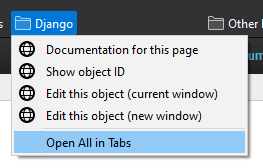
Now, I am supposed to be able to select bookmarklets from the non-admin pages in my webapp.
Here are my results of using each type of bookmarklet on the autogenerated documentation for my
core.Formulation Django model class, which was displayed at
http://localhost:8000/admin/doc/models/core.formulation/:
- Documentation for this page
-
This error message appeared:
formulation with ID “doc/views/django.contrib.admin.options.ModelAdmin.changelist_view” doesn’t exist. Perhaps it was deleted? - Show object ID
- Some of my webapp pages did not respond to this bookmarklet, while others displayed a small

divwhich did not contain useful information. Edit this object (current window)- Nothing happened. No error message on the JavaScript console.
Edit this object (new window)- Nothing happened. No error message on the JavaScript console.














